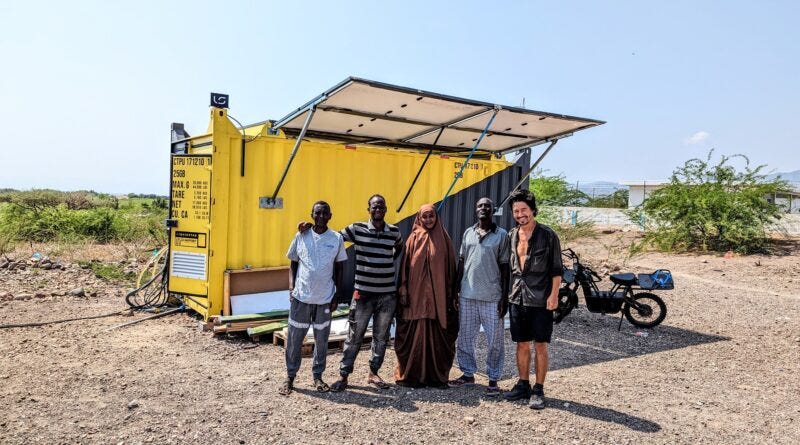A bank in a box
Greenfield, decentralized micro-finance.
What happened
Conversations with Conor Colwell of Liquidstar at d/acc Day in Taipei a couple of weeks ago.
Liquidstar’s financing problem
A Liquidstar Waypoint is e-infrastructure in a (big) box. It’s a solar-powered, water-generating, internet-connected, e-mobility-enabling micro-infrastructure, built for communities that live outside the grid. But it also costs 500,000 USD. Not easy for a remote community in Zambia or India to pull together.
Right now, most of that funding comes from top-down actors—USAID, local governments, development agencies. These sources work, but they don’t scale well. And they don’t allow for community ownership or long-term sustainability.
I had some conversations about these problems with Conor Colwell, a co-founder of Liquidstar. How do you build a financing model that allows communities to co-own this infrastructure, without depending entirely on grants or public procurement?
To start: finance the waypoint directly
The simplest option is to treat the Waypoint as an asset that can be debt-financed. Each unit generates $2,000–$5,000/month in revenue, depending on usage. That’s enough to support a long-term loan, especially if it’s low-interest and partially underwritten by a foundation or impact investor.
The upfront capital could come from a mix of philanthropic capital, sovereign funds, or impact investors—backstopping part of the risk. A portion (say, 30%) could be co-funded by local actors—either through in-kind contributions, pooled savings, or local governments. This kind of blended finance structure is relatively straightforward and keeps the repayment burden manageable.
What it also does is introduce a pathway to eventual community ownership. If the loan is paid down using local revenues, then ownership can transition accordingly.
Eventually: a bank in a box
The harder—but more transformative—approach is to layer financial services on top of the Waypoint itself. If a Waypoint becomes not just a utility hub but a local bank—offering deposits, loans, and digital wallets—it opens up a very different set of possibilities.
This could enable small loans for things like electric bikes, battery packs, or devices for remote work. It could also facilitate savings and local investment.
But doing this well is non-trivial. Any attempt to introduce crypto or token-based finance here runs the risk of predatory behavior, volatility, and reputational damage. If you’re holding deposits or lending to vulnerable users, the system needs to be extremely cautious, simple, and conservative. Not a DeFi experiment.
The core challenge is governance: who controls these financial rails, how is risk managed, and how are decisions made? Without good answers to those questions, it’s hard to move forward responsibly.
A transitional path
One pragmatic option is to start by financing the hardware through loans, and gradually layering in financial services as trust, governance, and infrastructure mature. In this model, the repayment of the initial Waypoint loan (to which everyone in the community can and should participate) could act as a form of credit history. The Waypoint becomes both infrastructure and an entry point to a broader economic system.
This is still speculative. But it’s worth exploring. Many of the communities targeted by Liquidstar's model lack not just infrastructure, but access to basic financial tools. Starting with something tangible—a battery charged, a phone connected, a jug of clean water—makes it easier to build from the ground up. But the question isn’t whether finance will be part of these systems—it’s what kind, and on whose terms.
Welcome to the community
Conor Colwell, co-founder of Liquidstar


